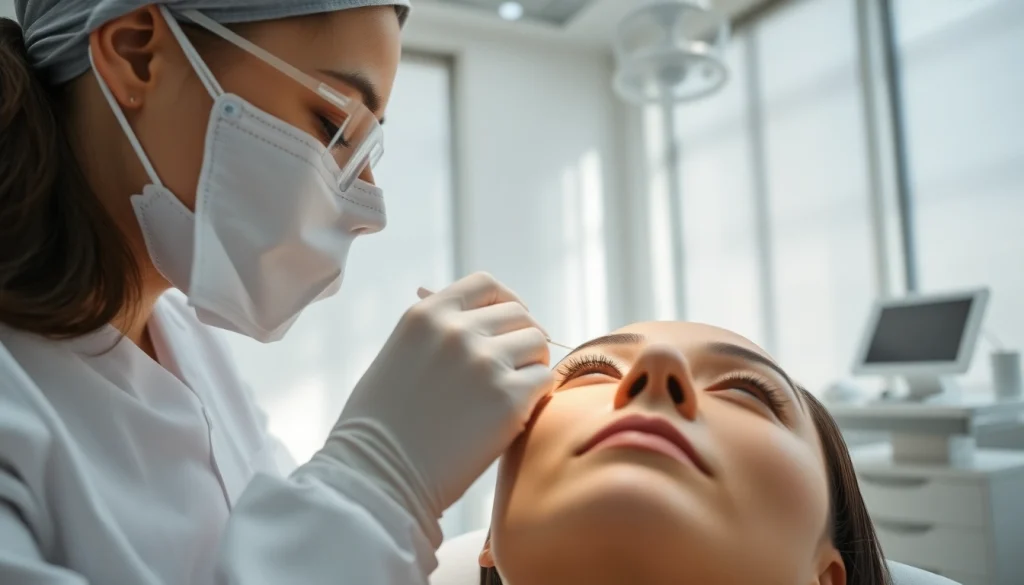Understanding the Fox Eye Thread Lift
What Is a Fox Eye Thread Lift?
The fox eye thread lift is a revolutionary cosmetic procedure designed to enhance the appearance of the eyes by extending the outer corners, giving them a more almond-shaped, youthful look. This minimally invasive technique utilizes threads to lift and reposition the skin around the eyes, creating a stunning, lifted effect that has garnered significant attention in the aesthetic community. The innovation behind this procedure lies in its ability to achieve results similar to those of traditional surgical methods, with significantly reduced downtime and lower risks associated with surgery. Patients seeking a more agile appearance often turn to the fox eye thread lift for a swift and effective solution to their aesthetic concerns.
Benefits of Choosing This Procedure
The benefits of the fox eye thread lift are multifaceted. Firstly, it provides immediate results that can improve the overall symmetry and shape of the eyes, which are often among the first features to showcase signs of aging. The procedure is designed to enhance facial contours and create a more defined look. Here are some notable advantages:
- Minimally Invasive: Unlike traditional facelifts, the fox eye thread lift requires no extensive incisions, leading to minimal scarring.
- Quick Recovery: This treatment typically has a shorter recovery period, allowing patients to return to their regular routines within a few days.
- Adjustable Results: Practitioners can adjust the tightness of the threads to achieve the desired degree of lift, providing personalized results.
- Natural Appearance: By using threads made from biocompatible materials, the enhancement appears natural and harmonious with the face’s existing features.
- Long-lasting Effects: While the results are not permanent, they can last from 6 months to 2 years depending on the individual’s skin type and lifestyle.
Who Is the Ideal Candidate?
The ideal candidate for a fox eye thread lift typically exhibits early signs of aging, such as sagging skin around the temples and eyes. It’s especially suited for individuals who desire a non-surgical option to rejuvenate their appearance without undergoing a full facelift. Additional criteria include:
- Individuals aged 30 to 55, though younger or older patients can also benefit.
- Those with moderate skin laxity and elastic skin.
- Patients who prefer a more subtle, lifted eye shape.
- Those in good general health, with no history of autoimmune diseases or skin infections.
Conversely, not everyone is a suitable candidate; people with certain medical conditions, such as bleeding disorders or active skin conditions near the treatment area, should consult a specialist to determine the appropriateness of the procedure.
The Procedure Explained
What to Expect During Your Appointment
Your appointment for a fox eye thread lift begins with a thorough consultation where the practitioner assesses your goals and skin condition. Following this evaluation, the area will be cleansed and numbed to ensure comfort during the procedure. Most sessions take between 30 to 90 minutes, depending on the complexity of the technique used and your individual anatomical considerations.
Common Techniques Used in the Procedure
The fox eye thread lift typically employs two main techniques: the “suspension” method and the “stabilization” technique. The suspension method involves threading fine sutures through the skin to create an initial lift. This is often combined with more traditional lifting techniques to achieve optimal results. The stabilization technique focuses on securing the threads in deeper layers of the skin for enhanced longevity. Practitioners may also use innovative threads with special barbs that grip the surrounding tissue, providing a more pronounced lifting effect.
Post-Procedure Care and Recommendations
After the procedure, some slight swelling and bruising are common reactions that typically dissipate within a few days. It’s crucial to follow post-procedure guidelines provided by your practitioner, which may include:
- Avoiding strenuous activities and exercise for at least a week.
- Refraining from facial massages and manipulation of the area.
- Using cold compresses to minimize swelling.
- Taking prescribed medications to manage discomfort, if necessary.
Most patients are advised to attend a follow-up appointment within two weeks to ensure proper healing and to make any necessary adjustments.
Comparing Fox Eye Thread Lift with Other Treatments
Fox Eye vs. Traditional Facelifts
While traditional facelifts and the fox eye thread lift aim to rejuvenate the face, they differ significantly in methodology, recovery time, and invasiveness. A traditional facelift involves more invasive techniques that can provide more dramatic results but also includes longer recovery times and potential complications. In contrast, the fox eye thread lift offers a less invasive approach with quicker healing times. However, results may not be as long-lasting as those achieved through surgery, making it essential for patients to align their expectations accordingly.
Other Non-Surgical Options for Eye Enhancement
Besides the fox eye thread lift, other non-surgical treatments for eye enhancement include dermal fillers, Botox, and laser treatments. Dermal fillers can help restore volume and smoothen wrinkles around the eyes, while Botox is effective for reducing fine lines caused by facial expressions. Laser treatments can tighten skin and improve texture around the eyes but won’t lift the skin as effectively as threads. Each option has unique benefits and limitations, emphasizing the importance of personalized assessment during consultations.
Cost Considerations for Each Option
Understanding the cost differences between the fox eye thread lift and other procedures is crucial for individuals weighing their options. A thread lift generally costs between $2,000 and $4,000, making it a more affordable option than traditional facelifts, which can range from $7,000 to $15,000 depending on the extent of the surgery. Non-surgical treatments can vary widely as well, with dermal fillers costing from $600 to $1,500 per session and Botox being priced at $10 to $20 per unit. Factors like the practitioner’s expertise and geographic location also influence the final price, highlighting the importance of thorough research and budgeting prior to undergoing any cosmetic procedure.
Preparing for Your Fox Eye Thread Lift
Consultation: Questions to Ask Your Provider
Your consultation is a vital step in preparing for a fox eye thread lift. It is essential to come prepared with questions that will help clarify the procedure, expectations, and any concerns you may have. Here are some critical inquiries to foster meaningful discussion with your provider:
- What is your experience and training in performing this specific procedure?
- Can you show me before-and-after photos of previous patients?
- What type of threads do you use, and how do they work?
- What specific results can I realistically expect based on my unique facial structure?
- What are the potential risks and side effects associated with this procedure?
How to Prepare Physically and Mentally
Preparing for your fox eye thread lift should involve both physical and mental readiness. Physically, you should avoid blood-thinning medications, alcohol, and anti-inflammatory drugs at least a week before your procedure to minimize bruising and facilitate healing. Eating a nutritious diet in the days leading up to your appointment can also support your body’s healing processes.
Mental preparation is equally important. It involves setting realistic expectations about the results, understanding the recovery process, and establishing a support system for postoperative days when you may need assistance. Visualizing positive outcomes can bolster your confidence as well.
Understanding Risks and Side Effects
Every cosmetic procedure comes with inherent risks, and the fox eye thread lift is no exception. Potential side effects may include:
- Temporary swelling or bruising around the eyes.
- Discomfort or tightness in the treated area.
- Visible sutures or uneven results if not performed skillfully.
- In rare cases, infection or allergic reactions may occur.
Discuss these risks with your practitioner to create a managed plan ensuring you are fully informed and comfortable with your decision.
Results and Maintenance
What Results to Expect After the Treatment
After the fox eye thread lift, most patients note a significant lift and youthful appearance immediately. As swelling subsides, results can be appreciated more clearly, typically within a week. The lifted look is natural and enhances facial harmony, allowing for greater confidence. However, it is essential to have realistic expectations, as outcomes will vary based on individual anatomy and the extent of the procedure.
Longevity of the Fox Eye Thread Lift Results
The results of a fox eye thread lift can last from 6 months to 2 years, depending on various factors such as skin quality, age, lifestyle, and maintenance practices. While the threads will eventually dissolve, stimulating collagen production may contribute to continued firmness in the treated area, offering prolonged aesthetic benefits. Regular follow-up visits can help monitor results and discuss any necessary adjustments.
Follow-up Treatments and Recommendations
While the fox eye thread lift can yield impressive results, it is not entirely permanent. Patients may choose to undergo follow-up treatments after a year to maintain their enhanced appearance. Other maintenance options include non-invasive treatments such as dermal fillers or Botox, providing wider options for overall facial rejuvenation. Your practitioner can help design a tailored maintenance strategy suited to your unique facial features and aesthetic goals.





